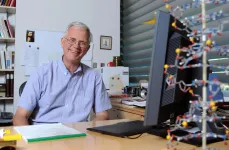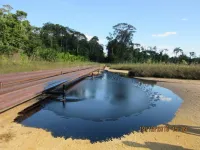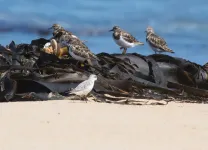(Press-News.org) La Jolla, Calif. (June 07, 2021) -- "The coronavirus pandemic has sparked what the World Health Organization has called an 'infodemic' of misinformation," said Dr. John W. Ayers, a scientist who specializes in public health surveillance. "But, bots --like those used by Russian agents during the 2016 American presidential election-- have been overlooked as a source of COVID-19 misinformation."
A new study published in JAMA Internal Medicine led by Dr. Ayers, Co-Founder of the Center for Data Driven Health and Vice Chief of Innovation within the Division of Infectious Diseases at the University of California San Diego in collaboration with the George Washington University and Johns Hopkins University suggests bots are the primary pathogen of COVID-19 misinformation on social media.
Identifying Bot Influence on Facebook Groups: A Case Study of Masks and COVID-19
The team identified public facebook groups that were heavily influenced by bots. The team measured how quickly the same URLs (or links) were shared in a sample of about 300,000 posts made to Facebook groups that shared 251,655 links.
When URLs are repeatedly shared by multiple accounts within seconds of one another, it indicates these are bot accounts controlled by automated software that coordinates their action. The team found that the Facebook groups most influenced by bots averaged 4.28 seconds between shares of identical links, compared to 4.35 hours for the Facebook groups least influenced by bots.
Among Facebook groups least or most influenced by bots, the team monitored posts that shared a link to the Danish Study to Assess Face Masks for the Protection Against COVID-19 Infection (DANMASK-19) randomized clinical trial published in the Annals of Internal Medicine. "We selected DANMASK-19 for our study because masks are an important public health measure to potentially control the pandemic and are a source of popular debate," said Dr. Davey Smith, study coauthor and Chief of Infectious Diseases at UC San Diego.
39 percent of all posts sharing the DANMASK-19 trial were made to Facebook groups that were the most influenced by bots. Whereas 9 percent of posts were made to Facebook groups the least influenced by bots.
20 percent of posts sharing the DANMASK-19 trial made to Facebook groups the most influenced by bots claimed masks harmed the wearer, contrary to scientific evidence. For example, one post read "Danish study proves...the harmfulness of wearing a mask." 50 percent of posts promoted conspiracies such as "corporate fact checkers are lying to you! All this to serve their Dystopian #Agenda2030 propaganda."
Posts sharing the DANMASK-19 trial made to Facebook groups the most influenced by bots were 2.3 times more likely to claim masks harm the wearer and 2.5 times more likely to make conspiratorial claims than posts made to Facebook groups made to Facebook groups the least influenced by bots.
The Threat of Automated Misinformation
"COVID-19 misinformation propaganda appears to be spreading faster than the virus itself," said Dr. Eric Leas, study coauthor and Assistant Professor at UC San Diego. "This is fueled by bots that can amplify misinformation at a rate far greater than ordinary users."
"Bots also appear to be undermining critical public health institutions. In our case study, bots mischaracterized a prominent publication from a prestigious medical journal to spread misinformation, said Brian Chu, study coauthor and medical student at UPenn. "This suggests that no content is safe from the dangers of weaponized misinformation."
"The amount of misinformation from bots we found suggests that bots' influence extends far beyond our case study," added Dr. Smith. "Could bots be fostering vaccine hesitancy or amplifying asian discrimination too?"
The team noted that the effect of automated misinformation is likely larger due to how it spills over into organic conversations on social media.
"Bots sharing misinformation could inspire ordinary people to propagate misinformed messages," said Zechariah Zhu, study coauthor and research associate with the Center for Data Drive Health at UC San Diego. "For example, bots may make platforms' algorithms think that automated content is more popular than it actually is, which can then lead to platforms actually prioritizing misinformation and disseminating it to an even larger audience," added Dr. David A. Broniatowski, Associate Director of the GW Institute for Data, Democracy, and Politics, and study coauthor.
A Call to Action to Address Automated Misinformation
"We must remember that unknown entities are working to deceive the public and promote misinformation. Their dangerous actions directly affect the public's health," said Dr. Mark Dredze, the John C. Malone Associate Professor of Computer Science at Johns Hopkins University and study coauthor.
Yet, solutions to eliminate bots and their misinformation campaigns are at hand the team notes.
"Our work shows that social media platforms have the ability to detect, and therefore remove, these coordinated bot campaigns," added Dr. Broniatowski. "Efforts to purge deceptive bots from social media platforms must become a priority among legislators, regulators, and social media companies who have instead been focused on targeting individual pieces of misinformation from ordinary users."
"If we want to correct the 'infodemic,' eliminating bots on social media is the necessary first step," concluded Dr. Ayers. "Unlike controversial strategies to censor actual people, silencing automated propaganda is something everyone can and should support."
INFORMATION:
While DNA provides the genetic recipe book for biological form and function, it is the job of the body's proteins to carry out the complex commands dictated by DNA's genetic code.
Stuart Lindsay, a researcher at the Biodesign Institute at ASU, has been at the forefront of efforts to improve rapid DNA sequencing and has more recently applied his talents to explore the much thornier problem of sequencing protein molecules, one molecule at a time.
In a new overview article, Lindsay's efforts are described along with those of international colleagues, who are applying a variety of innovative strategies for protein sequencing at the single-cell, and even single-molecule ...
The recent attacks against Asian Americans have put Asians in the U.S. in the spotlight. Many of the victims are first-generation immigrants in ethnic communities, while those rallying for the victims are second-generation Asian Americans. A new Dartmouth study explores who Asian Americans are today and the range of identities this category encompasses.
The study, by END ...
An international coalition of eye researchers used machine learning to develop classification criteria for 25 of the most common types of uveitis, a collection of over 30 diseases characterized by inflammation inside the eye. Together, these diseases are the fifth leading cause of blindness in the United States. The Standardization of Uveitis Nomenclature (SUN) Working Group, funded by the National Eye Institute (NEI), published its classification criteria in the American Journal of Ophthalmology. NEI is part of the National Institutes of Health.
"In the past, clinical research in the field of uveitis has been hampered by the lack of widely-accepted ...
Lead is a toxic metal, and its widespread use has led to significant environmental pollution and public health problems in many parts of the world. This has led the WHO to include it on a list of ten chemicals that cause serious health problems. However, lead poisoning continues to affect many population groups. A study published today in open access in the journal Environment International found high levels of lead in indigenous people in Peruvian Amazonia living near areas where oil extraction takes place. The research was led by Cristina O'Callaghan-Gordo, a professor and researcher in Health Sciences Studies at the Universitat Oberta de Catalunya (UOC) and the Barcelona ...
As Australia officially enters winter, UniSA ecologists are urging coastal communities to embrace all that the season brings, including the sometimes-unwelcome deposits of brown seaweed that can accumulate on the southern shores.
While tidal seaweed (or sea wrack) may seem unsightly - especially at beach-side tourist destinations - new research from the University of South Australia shows that it plays a vital role for many migratory seabirds and should be protected.
In the first study of its kind, UniSA researchers show that beach-cast seaweed provides shelter, ...
Osaka, Japan - In a new study, researchers from Osaka University discovered a novel molecular mechanism by which immune cells migrate to fight off infections. These findings may help in understanding the development of certain immune deficiency disorders and establish novel therapies against them.
Immune cells represent a diverse group of cells. Some circulate in the blood stream and migrate to infected tissues after receiving signals from damaged tissues. Others reside in tissues to take up the invading microbe, migrate to lymph nodes and activate an immune response. Therefore, to function effectively, the immune system's activities ...
June 7, 2021 - Nyon, Switzerland -- A new report by the International Osteoporosis Foundation (IOF) draws attention to the burden of osteoporosis and the gaps and inequalities in the provision of primary and secondary prevention of fractures due to osteoporosis across Europe. 'SCOPE 2021: a new scorecard for osteoporosis in Europe' provides detailed findings for the 27 countries of the European Union as well as Switzerland and the United Kingdom (referred to as 'EU27+2'), covering key indicators for four domains: burden of disease, policy framework, service provision and service uptake.
Professor John A. Kanis, IOF Honorary President and lead author of SCOPE, stated:
"Osteoporosis is a major concern in Europe as it results in 4.3 million fragility fractures and health ...
Scientists have established the most reliable estimates to date of past temperature variations in Antarctica.
They highlight significant differences in behaviour between West and East Antarctica.
This study makes it possible to test and consolidate future climate projections.
Antarctica has experienced significant temperature changes, especially since the last glacial period. An international collaboration including scientists from the CNRS1 has now challenged previously accepted estimates of these variations, using new measurements published on June 4, 2021 in Science. Their study highlights differences in behaviour between East and West Antarctica, connected in particular ...
New research identified a novel interaction between the SARS-CoV-2 spike protein and the galectin-3-binding protein (LGALS3BP) which could be a new therapeutic anti-viral target. The research also found the presence of detectable viral RNA in blood in COVID-19 patients is a strong predictor of mortality.
The paper, published today in Nature Communications, was led by a group of researchers from King's College London, Guy's and St Thomas' NHS Foundation Trust and King's British Heart Foundation Centre. The research was funded by the NIHR Guy's and St Thomas' Biomedical Research Centre and supported by grants from BHF.
In the study, authors analysed close to 500 blood samples from patients ...
Cows can pass on the hypoglycin A toxin through their milk, a study by the Martin Luther University Halle-Wittenberg (MLU) and the Leibniz Institute of Plant Biochemistry (IPB) in Toxins shows. The substance can cause severe symptoms in humans and animals. Small amounts of the toxin were detected in the raw milk of cows that grazed in a pasture exposed to sycamore maple. The team calls for further investigations to realistically assess the potential dangers.
High concentrations of hypoglycin A can be found in unripe akee and lychee fruit and in the seeds and seedlings of various maple trees. These include, for example, the sycamore maple, which is common throughout Europe. The toxin can cause severe illness in humans. In 2017, a team of researchers in India ...







